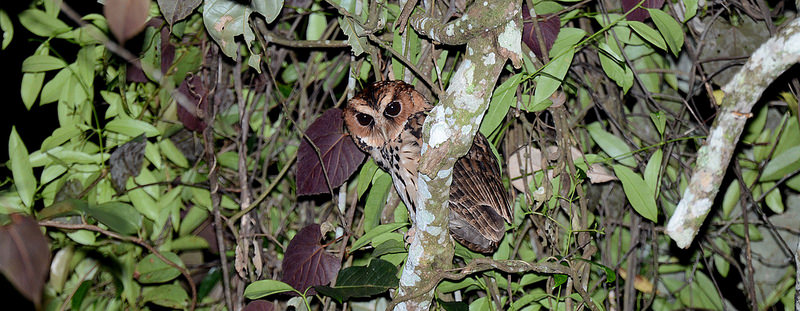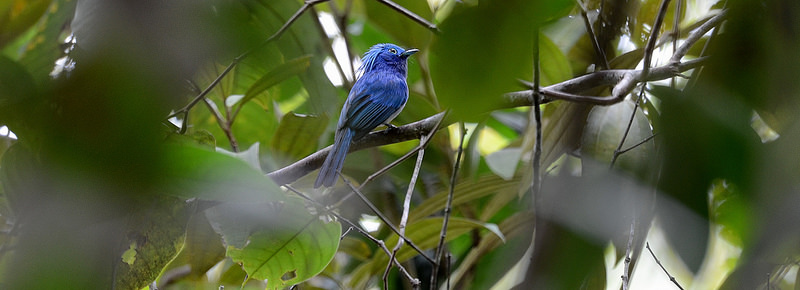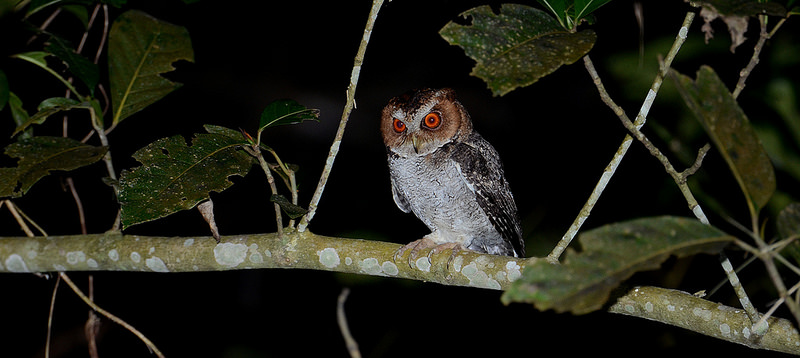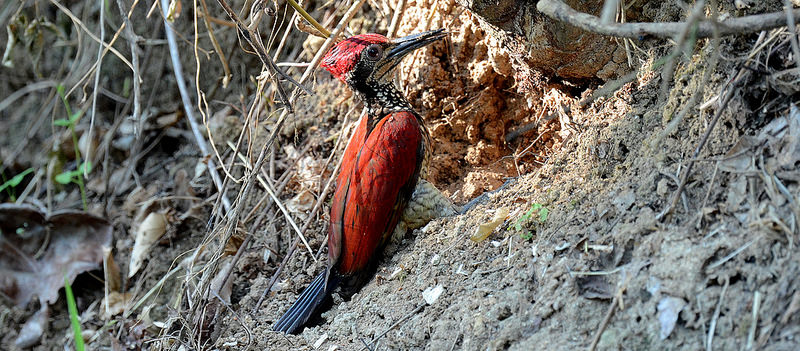
22 days Philippines Birding Tour 28 January - 18 February
Leader:Bram Demeulemeester
Participants:Deborah Bradley, Wayne Wycoff, William Grossi

Giant Scops-owl
We left Manila for the early morning flight to Cagayan De Oro where we began our hike to Mt. Kitanglad. The Del Monte Lodge would be our home for the next three nights while on the mountain. On our way hiking up the mountain, we were welcomed by a group of at least 30 Purple Needletails as well as plenty of Philippine Hanging Parrots moving around the trail as we made our way up the mountain. The Brown Shrikes, which are common winter visitors, were seen several times as well as two resident Long-tailed Shrikes. Among the more commonly seen birds during the hike were Tawny Grassbirds and Striated Grassbirds. We reached the lodge and had a few hours birding after our lunch. We saw two Yellow-breasted Fruit-Doves, Whiskered Treeswift, Yellow-bellied Whistler, two Elegant Tits, Artic Warbler, Little Pied Flycatcher, several Eye-browed Thrushes, as well as the more commonly seen Mountain White-eyes, up to six Cinnamon Ibons , and three Grey-hooded Sunbirds. Towards dusk, we waited at the clearing just above the Lodge for the soaring of the Bukidnon Woodcocks. Two were seen including one Philippine Nightjar. We made our way to the spot of the well-known Philippine Frogmouth and it showed very well that evening.
The following morning, we made our way slowly up towards the Philippine Eagle viewpoint. While birding along the way up, we spotted Philippine Cuckoo-Dove, up to twenty Philippine Hanging Parrots, one Philippine Coucal, plenty of Glossy Swiftlets over the open fields, and at least five Philippine Swiftlets seen higher up in the sky. More birds were seen that day including Two Whiskered Treeswifts, a Philippine Woodpecker, four Black-and-Cinnamon Fantails, Elegant Tit, Sulphur-billed Nuthatch, and Negros Warblers. A single Rufous-headed Tailorbird was also seen while two Grey-streaked Flycatchers, one Mugimaki Flycatcher, and six Turquoise Flycatchers were spotted as well. More than twenty Eye-browed Thrushes were seen being one of the more common winter visitors on the mountain. Mountain White-eyes were seen all day making it one of the most common birds seen on the trip. The Cinnamon Ibon was spotted among small flocks of birds and a single Short-tailed Starling was scoped. An Olive-capped Flowerpecker was seen once as well as a Fire-breasted Flowerpecker, and a Grey-hooded Sunbird. While waiting and scanning at the Philippine Eagle viewpoint, the group enjoyed prolonged views of a group of eight White-cheeked Bullfinches in the nearby trees and also three Stipe-breasted Rhabdornis. We waited for the Eagle for quite a while but it did not show up that day. We did we observe some Crested Honey-Buzzards and one Pinsker’s Hawk-Eagle as well as several Brahminy Kites as we made our way back towards our camp. We were all hoping for the Philippine Eagle to show the next day. At dusk, we had the chance to see the Bukidnon Woodcock again. Later that night, we had stunning views of the Giant Scops-owl which is always a great bird to end a birding day.
Most of the next morning was spent again at the Eagle viewpoint, with everybody hoping for the best. It was around 10 AM when we were alerted by the Eagle’s alarm call and not long after that, a Philippine Eagle flew toward the valley from behind us. We had the most amazing flight views that we could have ever hoped for. The long wait for this stunning raptor resulted in small dance of joy among the group members. A Philippine Serpent Eagle was also seen at the viewpoint. We decided then to make our way higher up the mountain in search of the higher montane birds that can be found there. The group saw Philippine Cuckoo-Dove, Philippine Swiftlet, two Mindanao Hornbills, two McGregor’s Cuckoo-shrikes, up to six Black-and-cinnamon Fantails, Mugimaki Flycatcher, Little Pied Flycatcher, and several Turquoise Flycatchers. Other birds seen were Black-masked White-eye, two Apo Mynas, Stripe-breasted Rhabdornis, and one Apo Sunbird. In the afternoon, we made our way back towards the lodge for our last night in Mt. Kitanglad. The next day, we walked downhill where our transport was waiting to transfer us to Bislig, our next destination. We reached our hotel later that evening.

Celestial Monarch
We started our first morning at the quarry trail in P.I.C.O.P and got a stunning view of an Azure-breasted Pitta. The pitta gave prolonged views and is always a great bird to start with. Our morning was spent birding between the Quarry Trail and Road 4 where we spotted two Pinsker’s Hawk-Eagles, four Philippine Falconets, Green Imperial-Pigeons, several Guaiaberos, Philippine Coucals, plenty Pygmy and Ameline Swiflets, two Whiskered Treeswifts, and one Rufous-lored Kingfisher. Other species seen were four Mindanao Hornbills, two White-bellied Woodpeckers, several Yellow-bellied Whistlers, Mindanao Drongo, Mindanao Blue Fantail, a single Short-crested Monarch, and a Rufous Paradise-Flycatcher made a brief appearance. We saw more species including four Yellow-wattled Bulbuls, several Yellowish Bulbuls, Philippine Leaf-Warblers, and one Black-headed Tailorbird was glimpsed through the dense bush. The group also saw two Philippine Magpie-Robins while two Striated Wren-Babblers showed very well. A large group of Brown Tit-Babblers also made an appearance as well as several Coletos, Red Keeled Flowerpecker, Orange-bellied Flowerpecker, one Metallic-winged Sunbird, Handsome Sunbird, and a single Naked-faced Spiderhunter. After our lunch break, we made our way towards the old Bislig airfield with one more stop made along Road 1 to look for the stunning Silvery Kingfisher that gave long scoping views while a Crested Goshawk was showing well in the nearby trees. We soon arrived at the airfield and saw quite a lot of wetland birds: Wandering Whistling Ducks, several Philippine Ducks, two Blue-breasted Quails, three Yellow Bitterns, two Cinnamon Bitterns, one Grey and four Purple Herons, one Barred Rail, two White-browed Crakes, one Purple Swamphen, and a single Common Moorhen. At least three Pin-tailed Snipes where flushed from the grasses and there were many responsive Middendorff’s Grasshopper-Warblers. We managed to get one in the scope giving the group very detailed views. Toward dusk, one Eastern Grass-owl showed very well in flight which was a very nice way to end our day.

Blue-capped Kingfisher
The next morning, we left very early again and headed towards Road 42 which is still the best remaining forest patch at the old logging concession area. We were welcomed by two Philippine Serpent-Eagles, one Crested Goshawk, Pinsker’s Hawk-Eagle, three Philippine Falconets, two White-eared Brown Doves, Violet Cuckoo, and two Philippine Needletails. Two Philippine Trogons gave short views and a female Blue-capped Kingfisher showed for some time. Other birds seen were two Mindanao Hornbills, one Buff-spotted Flameback, one Scarlet Minivet, and a Philippine Oriole. Several Mindanao Drongos (Spangled) and two Mindanao Blue Fantails also showed well. The highlight of our visit to P.I.C.O.P was four sightings of Celestial Monarchs, with one of the males showing its raised crest, an uncommon sight of this most wanted bird here in the fast-vanishing forests of Eastern Mindanao. More birds were seen in the area including a Rufous Paradise- Flycatcher, several Yellow-wattled Bulbuls, Rufous-fronted Tailorbird, Mindanao Pygmy Babbler, Olive-backed Flowerpecker and Bicoloured Flowerpecker, two Metallic-winged Sunbirds, three Handsome Sunbirds, and a single Naked-faced Spiderhunter. We made our way back to the hotel later that afternoon for our last night stay on the island of Mindanao. Next morning we had a flight to Cebu.

Crested Goshawk at P.I.C.O.P
The group had two whole days to bird in the Rajah Sikatuna Natural Park in the island of Bohol. Birding was mostly done along the trail within the park where a Philippine Drongo-Cuckoo and at least three Black-faced Coucals were seen. We got splendid views of the Northern Silvery Kingfisher and six Samar Hornbills and Buff-spotted Flameback were seen. One of the most wanted birds on Bohol is the Visayan Wattled Broadbill which was seen in a mixed flock but was sadly missed by two of the participants. Several other birds were seen in the mixed flock including Yellow-bellied Whistler, Spangled Drongo, Visayan Blue Fantail, Black-naped Monarch, several Philippine Leaf-Warblers, and Rufous-fronted Tailorbird. After a few attempts, we spotted a Yellow-breasted Tailorbird, which is always a tricky bird to see well. Three Rufous-tailed Jungle-Flycatchers were seen very well as well as a few Brown Tit-Babblers. Black-crowned Babbler was only glimpsed among the bird flocks once. Coletos, Purple-throated Sunbirds, and Olive-backed Sunbirds where all seen several times that day. At dusk, several Great Eared Nightjars were seen flying over the clearing and we also had the chance to spot a Luzon Hawk-owl. Birding did not end at the park as an Everett’s Scops-owl was seen at the garden of our accommodations. Two good birding days were spent on Bohol before we made our way to South Negros by ferry.
Our first full day on the island of Negros was spent birding around Lake Balinsasayao. This site is always good to spot some of the Negros specialties making it a good site to start with. The Visayan subspecies of the Amethyst Brown Dove was heard calling and gave the group some prolonged views which was a very good start to find this rarely seen bird. There were a number of bird flocks and the group was able to see several of the Negros specialties including White-winged Cuckoo-shrike, White-vented Whistler, Visayan Balicassiao, Visayan Fantail, Elegant Tit, Sulphur-billed Nuthatch, and Lemon-throated Warbler. We also spent some time watching the different sunbirds from the lake’s restaurant view deck. We got stunning views of Maroon-naped Sunbird and Magnificent Sunbird, two recent splits of Visayan endemics. Philippine Tailorbird was also spotted in the dense undergrowth. Coleto, Visayan Bulbuls, and four Visayan Hornbills were also seen very well. On our second day, we left very early from the city of Dumaguete to visit Mt.Maniquil. We made one stop along the way to look for the Visayan Shama as we made our way to the base of the mountain. We started our two-hour walk to reach the edge of the montane forest. As soon we entered the forest we started to look out for our main target bird at this site, the Negros Striped-Babbler. We spotted it after some time searching. Also seen were four White-winged Cuckoo-shrikes, Visayan Balicassiao, Elegant Tit, Sulphur-billed Nuthatch, Negros Warbler, and Mountain White-eye. Later that afternoon, we made our way to Valencia, the home town from our local guide. We spent most of the afternoon birding around his garden with nice long views of Philippine Hawk-Cuckoo and Black-belted Flowerpecker. Later that evening, we spent several hours searching for the smallest owl in the Philippines, the Negros Scops-Owl. A pair gave the group stunning close views that evening. We made our way back to Dumaguete for a good rest after a long day in the field. The next day, before we had to take our flight back to Manila, we visited a valley near Valencia where we spotted several flocks holding at least two Flame-templed Babblers, a stunning bird and a nice ending to our visit in Negros.

Negros Scops-owl
We started very early for a pre-dawn visit in the forest on Mt. Makiling. That resulted in very close views of a Philippine Scops-Owl. As it started to get light, the Spotted Wood Kingfishers started to call and we were able to see three of these stunning Kingfishers. We made our way slowly up the mountain with a single White-browed Shama seen in the dense forest. Black-chinned Fruit-Dove, Rough-crested Malkoha, and Scale-feathered Malkoha were among the star birds on the mountain and it is always good to see several of these stunners. Philippine Trogon and Luzon Flameback were seen along the trail as well as at least five Luzon Hornbills. Balicassiao were commonly seen and an Ashy Thrush was briefly seen on our way to the mud springs. Two Flaming Sunbirds and Grey-throated Sunbirds gave good views as well as Red-keeled Flowerpecker. We spent some time trying to spot a calling Luzon Bleeding-heart but unfortunately it remained hidden. We made our way back down the mountain for lunch. The afternoon was spent at the Botanical Gardens in search of the Indigo-banded Kingfisher. It gave prolonged scope views to end a successful day birding on. Next morning, we spent some time in the open fields inside the university campus to search for the Spotted Buttonquail that was seen crossing the track. Soon we were on our way to Candaba Marsh.
We spent our afternoon at the Candaba Marsh, which was along our way to Subic Bay. The group saw plenty Wandering Whistling-Ducks and Philippine Ducks, Northern Shovelers, Garganeys , Green-winged Teals, Tufted Ducks, and several Little Grebes. Yellow Bittern and Cinnamon Bittern were seen several times. There were also plenty Grey and Purple Herons, Intermediate Egrets, Little Egrets, and Black-crowned Night-Herons. An Eastern Marsh Harrier, up to eight Barred Rails, White-breasted Waterhen, and Purple Swamphens were also seen. We also had the chance to spot several waders on the rice paddies including Kentish Plovers, Common Sandpipers, Common Greenshank, March Sandpipers, Wood Sandpipers, one Long-toed Stint, two Oriental Pratincoles, and two Greater Painted-snipes. There were also plenty of Whiskered Terns and Red Collared-Dove and Spotted Doves were commonly seen. In the grasslands, Blue-tailed Bee-eater, Striated Grassbirds, and Paddyfield Pipits were observed. The best observation was a group of at least 40 White-shouldered Starlings and an Eastern Grass Owl that was seen on our way out. Soon we were on our way to Subic Bay.

Luzon Flameback
The next morning we were out early again in the field for a full day birding at Subic Bay. The forest had many Philippine Green-Pigeons, Green Imperial-Pigeons, and plenty of Guaiaberos. Eight Green Racquet-tails and several Blue-naped Parrots were also seen. A Rough-crested Malkoha, a small group of Rufous Coucals, and a Philippine Coucal were seen very well. The group had prolonged views of Rufous crowned Bee-eaters at their nesting colony and it is always nice to spend some time watching these stunning birds. A small group of Luzon Hornbills were also seen. Subic is a woodpecker’s paradise and the group saw two White-bellied Woodpeckers, Northern Sooty Woodpeckers, as well as five Luzon Flamebacks, with one of them coming really close and low along the road giving perfect photographic opportunities. Bar-bellied Cuckoo-shrikes were commonly seen and Blackish Cuckoo-shrike was seen on several occasions as well as a small group of six wintering Ashy Minivets. Other birds seen include Black-naped Orioles, Balicassiaos, Red-keeled Flowerpecker, and Large-billed Crows. Surely the bird of the day was a single White-fronted Tit, which gave prolonged views and is one of the harder birds to find these days at Subic Bay. Trilling Tailorbird was seen as well as the more common Coletos. At night, we spotted one Chocolate Boobook, a nice way to end our day. The next day we still had several hours birding around the many roads in Subic before we left for the airport in Manila to catch our evening flight to Puerto Princesa on Palawan, the last leg in our tour.
We started our first morning in Palawan in the Balsahan Trail. It is always a good spot to start with on Palawan as it gives a nice introduction to some of the Palawan specialties such as the Palawan Flycatcher and Melodious Babbler. We saw both species that morning along with Green Imperial-Pigeons, two Chestnut-breasted Malkohas, Palawan Drongos, our first views of the stunning Blue Paradise-Flycatcher, Palawan Crows, and the endemics Ashy-fronted and Palawan Bulbuls were also seen. A single Palawan Blue-Flycatcher made an appearance and Rufous-tailed Tailorbird was more often heard then seen. Other birds seen were White-vented Shama, an Ashy-headed Babbler, and the very common Pin-striped Tit-Babblers. Also seen were four Yellow-throated Leafbirds, Palawan Flowerpecker, Lovely Sunbird, and Pale Spiderhunter. After several hours on the trail and a nice start for our Palawan visit, we made our way back to the main road with several stops to scan the rice paddies which had several wintering birds: Kentish Plover, many Black-winged Stills, Common Sandpipers, Common Greenshanks, Marsh Sandpipers, Common Redshank, lots of Wood Sandpipers, Red-necked Stints, a single Long-toed Stint, and twenty Oriental Pratincoles.
Soon we were on our way for lunch back in Puerto Princesa at our favorite sea food restaurant at the sea front. The mangroves around the restaurant are always a good place to spot Stork-billed Kingfishers and Copper-throated Sunbirds. After our break we made our way along the beach front in search of Chinese Egrets and two individuals were seen as well as Intermediate Egrets, Little Egrets, and Grey-tailed Tattlers. Before dusk, we went to the small offshore island to wait for night time for some owling. While waiting, we spotted in the distance a White-bellied Sea-Eagle. As darkness came, a Mantanani Scops-Owl was seen well. We ended our long day birding with a Spotted Wood-Owl in Puerto Princesa.

Blue Paradise Flycatcher
The following morning we were early on the road towards Sabang Beach. We made several stops along the way to seek out more of the Palawan endemic birds. The group was able to see Crested Serpent Eagle, Crested Goshawk, Philippine Cuckoo Dove, Green Imperial Pigeons, three Blue-headed Racquet-tails, Blue-naped Parrot, Plaintive Cuckoo, Square-tailed Drongo, two Chestnut-breasted Malkohas, and Dollarbirds. We also saw a lot of woodpeckers including several Spot-throated Flamebacks and the very cool-looking Red-headed Flameback. We also observed a family of three Great Slaty Woodpeckers. It is always nice to observe such prehistoric-looking birds. A lot more birds showed that morning including a single Bar-bellied Cuckoo-shrike, two Dark-throated Orioles, Ashy Drongos and Palawan Drongos, Blue Paradise-Flycatcher, Palawan Crows, four Palawan Tits, two Velvet-fronted Nuthatches, plenty Black-headed Bulbuls, Ashy-fronted and Palawan Bulbuls, one Asian Fairy-bluebird, and Grey-streaked Flycatchers. White-vented Shama was also seen again. While walking along the road, a distant call was heard from the Falcated Wren-Babbler, which was seen very well later on and is always a stunning bird to see. Added to our list were two Common Hill Mynas, plenty of Yellow-throated Leafbirds, Palawan Flowerpeckers, Pygmy Flowerpecker, Brown-throated and Purple Throated Sunbirds, Olive-backed Sunbird, Lovely Sunbirds, and a Pale Spiderhunter. Towards the evening, we spent our time watching out for the Philippine Cockatoos and four of these magnificent birds were seen. At night, we tried our chances this time for the very elusive Palawan Scops-Owl. We heard it a few times only but sadly it remained hidden for our entire visit. The next morning, we tried our chances for the owl again but only a nice Palawan Frogmouth was seen very well. Shortly after breakfast we were on our way to the Underground River for the star bird of Palawan, the famous Palawan Peacock-Pheasant. We had stunning views of this amazing shiny Pheasant and also good views of the Philippine Scrubfowl. After some time enjoying the scenic area and the Peacock-Pheasant, we made our way back to Puerto Princesa and of course for more birding along the road. This time we saw two Blue-naped Parrots, Lesser Coucals, and a group of six Palawan Hornbills, which was a more than welcome sighting. We again saw Spot-throated Flameback, a single Fiery Minivet, two wintering Grey-streaked Flycatchers, several Yellow-throated Leafbirds, Palawan Flowerpeckers, and Purple-throated Sunbirds.
On our last night on the island, we had the chance to bird again the following day on our way to the airport for our flight to Manila. We spotted several more birds in the early morning including two Large-tailed Nightjars, Philippine Cuckoo Dove, one Black-chinned Fruit-Dove, plenty Green Imperial-Pigeons, Blue-naped Parrots, Square-tailed Drongo, Spot-throated Flameback, one Common Iora, two Fiery Minivets, three Dark Throated Orioles, Ashy and Palawan Drongos, Black-naped Monarch, Rufous-tailed Tailorbird, three Asian Fairy-bluebirds, Yellow-throated Leafbird, Palawan Flowerpeckers, two Brown-throated Sunbirds, lots of Purple-throated Sunbirds, Olive-backed Sunbirds, and Lovely Sunbird. We saw quite a lot just before our flight and it was a nice way to end our twenty two day tour. We flew back to Manila for one overnight stay and then the next morning we made our way to the airport for the group’s international flight.

